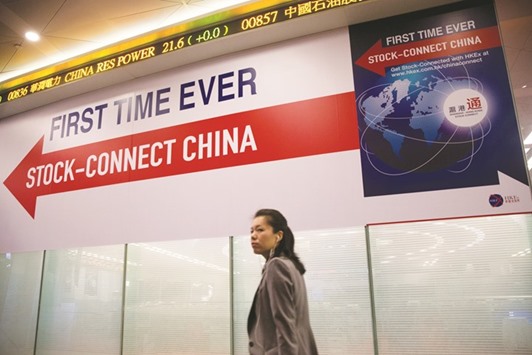China’s investors want out, and foreigners aren’t showing much appetite to jump in.
A programme allowing some domestic and Hong Kong mutual funds to be sold on either side of the border has seen about 37 times more money leave China than enter so far this year. In addition, a link between the Shanghai and Hong Kong stock exchanges has to date enabled southbound outflows that are 39% more than the amount that’s moved north.
In the first quarter, Chinese residents also poured a record HK$13.2bn ($1.7bn) into Hong Kong’s insurance products, a popular way to move funds offshore.
As China opens the door wider to foreign funds, concern about the country’s slowing economy and debt burden is limiting overseas interest in its stocks and fixed-income assets.
Analysts say that while flows through existing programmes remain lopsided, policy makers will be wary of further loosening controls on how much domestic fund managers can invest offshore. The yuan is set for a third annual loss versus the dollar, even after central bank support that’s led to an $800bn decline in the nation’s foreign-exchange reserves over the past two years.
“The efforts to encourage inflows and contain outflows will probably to be in place until the end of this year unless the trend of capital outflows reverses,” said Larry Hu, head of China economics at Macquarie Securities in Hong Kong. “This may hold up capital-account opening, but at this time the Chinese authorities are choosing to pay more attention to capital flows, the exchange rate and stability.”
The Qualified Domestic Institutional Investors program that allows local fund managers to raise money onshore for offshore investments last had new quota approved in March 2015. Trial programmes for QDII2, which would allow individuals to buy overseas property and securities directly, have yet to get off the ground three years after being reported in official media.
A proposed link connecting the Shenzhen and Hong Kong stock exchanges also has still to start despite preparations having been completed in July 2015.
China is pushing for domestic stocks and bonds to be included in global benchmarks to encourage greater foreign ownership of its securities. It also this month granted US investors a 250bn yuan ($38bn) quota to invest in onshore markets, the second-largest allocation under its Renminbi Qualified Foreign Institutional Investor program.
“Structurally, Chinese residents, who didn’t have channels to invest offshore, have the need to diversify their assets, while foreign investors, who didn’t have access to enter the market, need to increase their allocations to the world’s second-largest economy,” said Aidan Yao, Hong Kong-based senior economist at AXA Investment Asia, which had $759bn of assets under management at the end of March. “However, cyclical factors are deterring foreign investors from aggressively allocating funds to onshore assets as China’s economic prospects don’t look strong. If the outbound programs open now, domestic investors would have strong appetite to invest overseas.”
QFII and RQFII quotas allowing inward investment have increased 29% to $157bn since March 2015, while QDII allocations to send money abroad were held at $89.99bn.
Local asset managers including Bosera Asset Management Co and GF Fund Management Co have halted subscriptions to some of their mutual fund products after exhausting their limits.
The yuan is trading near a five-year low of 6.6585 per dollar and is forecast to weaken to 6.70 by year-end, based on the median estimate in a Bloomberg survey. The nation’s 10-year bond yield of 2.87% is the highest on offer in the world’s five biggest economies and compares with 1.46% in the US and negative rates in Japan and Germany. The Shanghai Composite Index of shares has lost 17% this year, making it one of the five worst-performing markets globally.
“Without government restrictions, I suspect portfolio outflows will exceed inflows in the next couple years,” said Liao Qun, Hong Kong-based chief economist at Citic Bank International. “With the policy guidance, the gap may narrow, but to completely reverse the trend, it’d still be difficult.”
The net flow of money to Hong Kong from China under the mutual fund recognition program amounted to 2.07bn yuan in the first five months of this year, while flows in the opposite direction were only 55.9mn yuan, SAFE data show. Local residents bought 186bn yuan of Hong Kong equities via the existing stock-exchange link, versus 133.9bn yuan of mainland stocks purchased from Hong Kong, data compiled by Bloomberg show.
The remaining southbound quota may be depleted by July based on the current pace of use, according to Daiwa Capital Markets Hong Kong. There may be even stronger southbound inflows in coming weeks as Chinese investors start to compete for the remaining quota, Chang Yuliang, Hong Kong-based strategist at Deutsche Bank, wrote in a note.
China’s foreign-exchange reserves fell to $3.19tn last month, the lowest level since 2011, official data show.
“While the government has been taking measures to stimulate inflows, a relatively weak economy seems to have yet to persuade foreign investors to aggressively allocate into onshore markets,” said Xia Le, chief economist for Asia at Banco Bilbao Vizcaya Argentaria in Hong Kong.
“Money flows in both ways will increase over the years, but the net effect will probably be outbound rather than inbound in the near future.”

A woman walks past a banner reading ‘First Time Ever, Stock-Connect China’ during the launch ceremony of the Shanghai-Hong Kong Stock Connect at the Hong Kong Stock Exchange (file). The link between the Shanghai and Hong Kong stock exchanges has to date enabled southbound outflows that are 39% more than the amount that’s moved north.
